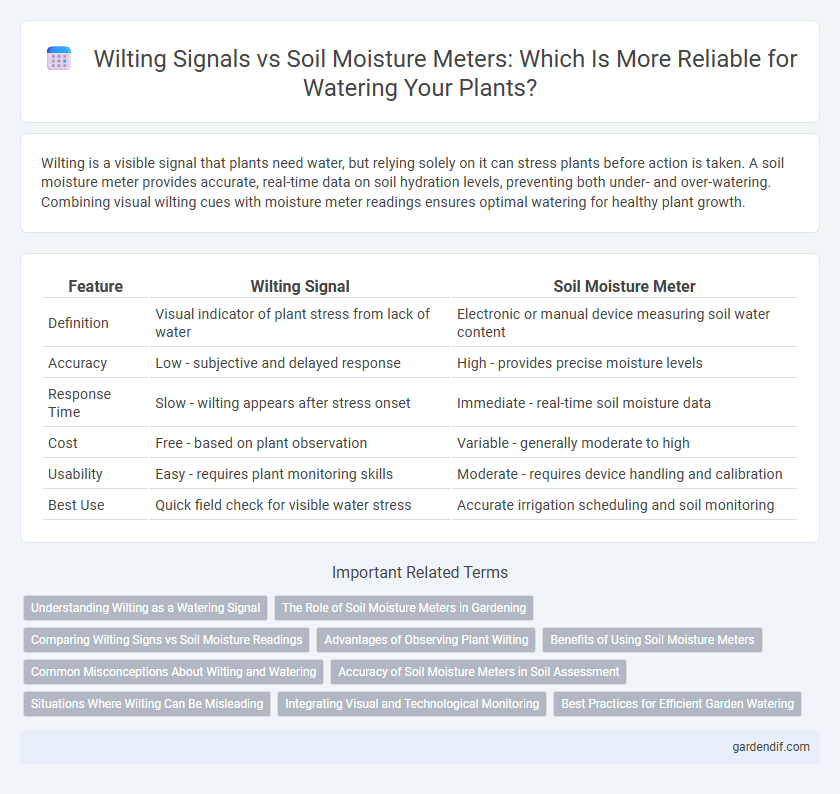
Wilting signal vs Soil moisture meter Illustration
Wilting is a visible signal that plants need water, but relying solely on it can stress plants before action is taken. A soil moisture meter provides accurate, real-time data on soil hydration levels, preventing both under- and over-watering. Combining visual wilting cues with moisture meter readings ensures optimal watering for healthy plant growth.
Table of Comparison
| Feature | Wilting Signal | Soil Moisture Meter |
|---|---|---|
| Definition | Visual indicator of plant stress from lack of water | Electronic or manual device measuring soil water content |
| Accuracy | Low - subjective and delayed response | High - provides precise moisture levels |
| Response Time | Slow - wilting appears after stress onset | Immediate - real-time soil moisture data |
| Cost | Free - based on plant observation | Variable - generally moderate to high |
| Usability | Easy - requires plant monitoring skills | Moderate - requires device handling and calibration |
| Best Use | Quick field check for visible water stress | Accurate irrigation scheduling and soil monitoring |
Understanding Wilting as a Watering Signal
Wilting serves as a natural indicator of water deficiency in plants, signaling an urgent need for hydration before irreversible damage occurs. Unlike a soil moisture meter that provides precise quantitative readings of soil water content, wilting reflects the plant's physiological response to inadequate moisture uptake. Observing wilting patterns enables gardeners to gauge plant stress levels and adjust watering schedules more intuitively, complementing the technical data from soil moisture meters for optimal irrigation management.
The Role of Soil Moisture Meters in Gardening
Soil moisture meters play a crucial role in gardening by providing precise measurements of soil water content, allowing gardeners to avoid overwatering or underwatering plants. Unlike wilting signals, which indicate stress only after a plant has already suffered water deficiency, moisture meters offer real-time data to maintain optimal hydration levels. This technology enhances plant health, promotes efficient water use, and supports sustainable gardening practices.
Comparing Wilting Signs vs Soil Moisture Readings
Wilting signals provide a visual indication of plant water stress, reflecting immediate physiological responses such as drooping leaves and reduced turgor pressure. Soil moisture meters deliver precise quantitative data on soil water content, enabling early detection of inadequate moisture before wilting occurs. Combining wilting observations with soil moisture readings offers a comprehensive approach for optimal irrigation scheduling and plant health monitoring.
Advantages of Observing Plant Wilting
Observing plant wilting provides immediate, visual cues about a plant's water stress, enabling rapid response without the need for specialized tools. Wilting reflects the plant's actual physiological condition, capturing water deficits at the cellular level more accurately than soil moisture meters. This method allows gardeners to tailor watering schedules based on the plant's specific needs rather than relying solely on soil data.
Benefits of Using Soil Moisture Meters
Soil moisture meters provide precise and real-time readings of soil water content, enabling gardeners to water plants only when necessary, preventing overwatering and promoting healthier root development. Unlike wilting signals, which are late indicators of plant stress, moisture meters detect early soil dryness, improving irrigation efficiency and conserving water. This technology supports optimal plant growth by ensuring consistent moisture levels tailored to specific plant needs.
Common Misconceptions About Wilting and Watering
Wilting is often mistaken as a definitive sign of underwatering, but it can also indicate overwatering or root damage, making soil moisture meters a more reliable tool for accurate watering decisions. Soil moisture meters measure the actual water content at the root level, preventing the common misconception that wilting always signals dryness. Relying solely on wilting can lead to inconsistent watering practices, whereas soil moisture data supports healthier plant growth by ensuring optimal hydration.
Accuracy of Soil Moisture Meters in Soil Assessment
Soil moisture meters provide precise and quantifiable data on soil hydration levels, offering a more accurate assessment than wilting signals, which are subjective and delayed indicators of plant stress. These meters measure volumetric water content directly, enabling timely and targeted watering decisions that prevent over- or under-watering. Their accuracy varies by sensor type but generally exceeds visual cues, making them essential tools for efficient irrigation management.
Situations Where Wilting Can Be Misleading
Wilting can sometimes signal water stress, but it may also result from environmental factors like excessive heat or root damage, making it an unreliable indicator alone. Soil moisture meters provide precise, quantifiable readings of soil water levels, reducing guesswork in irrigation decisions. Relying solely on wilting without moisture meter data can lead to overwatering or underwatering, harming plant health.
Integrating Visual and Technological Monitoring
Wilting signals provide immediate, visible indications of plant stress, while soil moisture meters deliver precise, quantifiable data on soil hydration levels. Integrating these methods enhances watering efficiency by combining real-time visual cues with accurate soil moisture readings, enabling timely and informed irrigation decisions. This dual approach minimizes water waste and promotes healthier plant growth through optimized moisture management.
Best Practices for Efficient Garden Watering
Wilting signals in plants provide a natural indicator for when watering is needed, but relying solely on wilting can stress plants and reduce growth. Soil moisture meters offer precise measurements of root-zone moisture levels, enabling gardeners to water only when necessary and avoid overwatering. Combining visual wilting cues with regular soil moisture readings ensures optimal hydration, promoting healthier plants and conserving water resources.
Wilting signal vs Soil moisture meter Infographic

 gardendif.com
gardendif.com